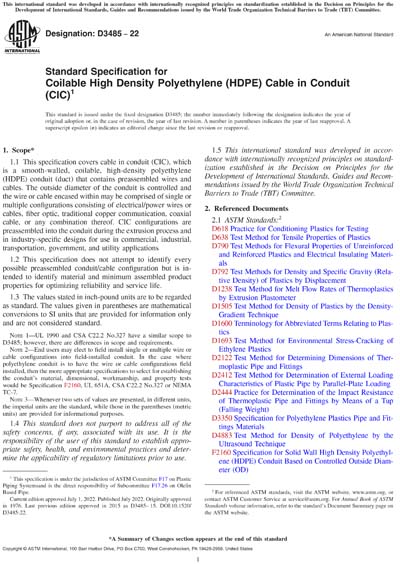Most recent
ASTM D3485-22
Standard Specification for Coilable High Density Polyethylene (HDPE) Cable in Conduit (CIC)
1.1This specification covers cable in conduit (CIC), which is a smooth-walled, coilable, high-density polyethylene (HDPE) conduit (duct) that contains preassembled wires and cables. The outside diameter of the conduit is controlled and the wire or cable encased within may be comprised of single or multiple configurations consisting of electrical/power wires or cables, fiber optic, traditional copper communication, coaxial cable, or any combination thereof. CIC configurations are preassembled into the conduit during the extrusion process and in industry-specific designs for use in commercial, industrial, transportation, government, and utility applications
1.2This specification does not attempt to identify every possible preassembled conduit/cable configuration but is intended to identify material and minimum assembled product properties for optimizing reliability and service life.
1.3The values stated in inch-pound units are to be regarded as standard. The values given in parentheses are mathematical conversions to SI units that are provided for information only and are not considered standard.
Note 1:UL 1990 and CSA C22.2 No.327 have a similar scope to D3485; however, there are differences in scope and requirements.
Note 2:End users may elect to field install single or multiple wire or cable configurations into field-installed conduit. In the case where polyethylene conduit is to have the wire or cable configurations field installed, then the more appropriate specifications to select for establishing the conduit's material, dimensional, workmanship, and property tests would be Specification F2160, UL 651A, CSA C22.2 No.327 or NEMA TC-7.
Note 3:Whenever two sets of values are presented, in different units, the imperial units are the standard, while those in the parentheses (metric units) are provided for informational purposes.
1.4This standard does not purport to address all of the safety concerns, if any, associated with its use. It is the responsibility of the user of this standard to establish appropriate safety, health, and environmental practices and determine the applicability of regulatory limitations prior to use.
1.5This international standard was developed in accordance with internationally recognized principles on standardization established in the Decision on Principles for the Development of International Standards, Guides and Recommendations issued by the World Trade Organization Technical Barriers to Trade (TBT) Committee.
Content Provider
ASTM International [astm]






